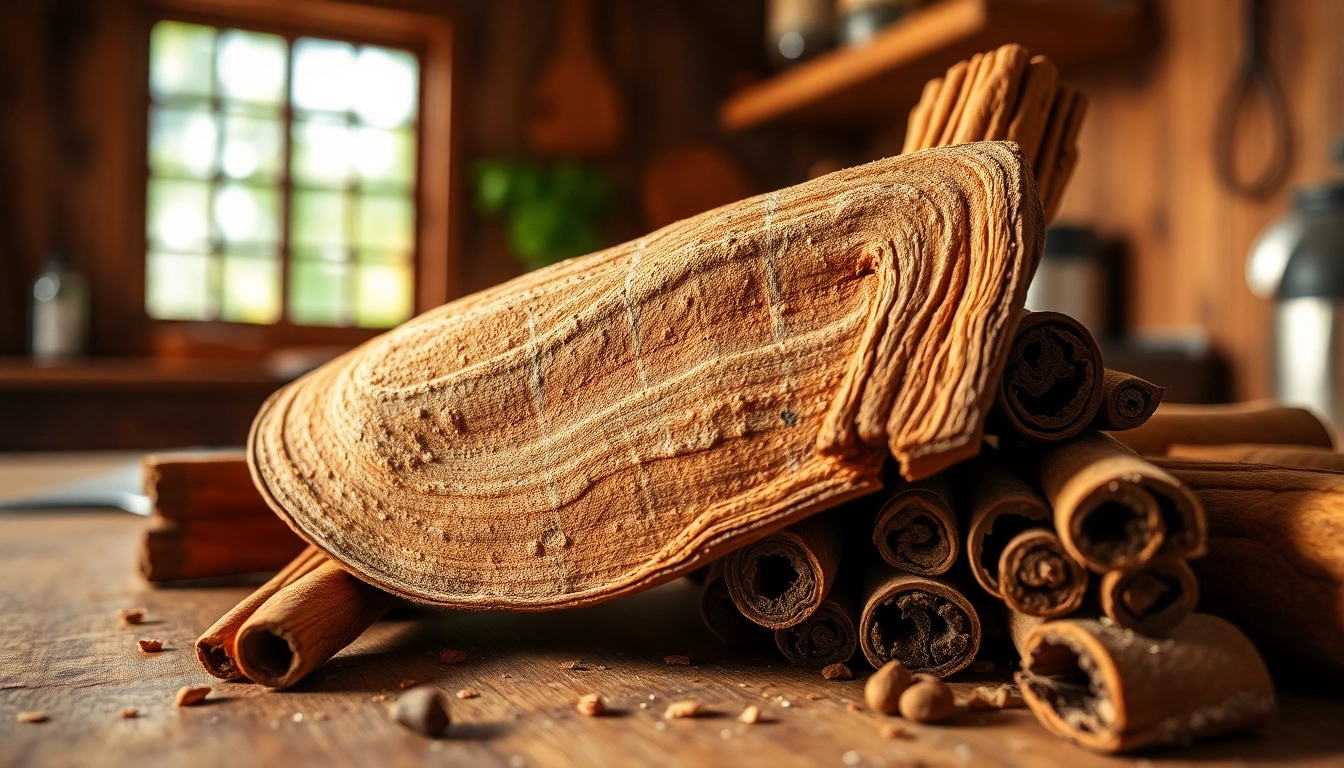Cinnamon Bark Benefits: Health Advantages and Culinary Uses
Understanding Cinnamon Bark
1. What is Cinnamon Bark?
Cinnamon bark, a spice derived from the inner bark of trees belonging to the genus Cinnamomum, has been cherished for centuries for its aromatic flavor and rich medicinal properties. The bark is obtained by harvesting the stems of the cinnamon tree, allowing the inner bark to curl as it dries, forming the quills or sticks commonly recognized in kitchens worldwide. Its unique flavor profile, characterized by sweet and warm notes, makes it a popular ingredient in various culinary traditions.
Moreover, cinnamon bark has been traditionally used in herbal medicine, showing promising health benefits that have captured modern scientific interest. This duality as both a culinary and medicinal ingredient makes it a versatile asset in any diet. For more culinary inspiration, you might explore how Cinnamon Bark can enhance the flavors of your favorite dishes.
2. Types of Cinnamon: Ceylon vs. Cassia
Cinnamon is primarily categorized into two types: Ceylon cinnamon, often referred to as “true” cinnamon, and Cassia cinnamon, which is the more commonly available variety. Ceylon cinnamon (Cinnamomum verum) is characterized by its light brown color, delicate flavor, and superior aromatic qualities. It has a sweet taste with notes of citrus and is often preferred in high-end culinary applications, particularly in European cuisines.
In contrast, Cassia cinnamon, primarily produced from Cinnamomum cassia, has a darker hue and a stronger, spicier flavor. It is more readily available and less expensive, making it a ubiquitous choice for everyday cooking and baking. However, it contains higher levels of coumarin, a compound that can be toxic in large quantities. Understanding these differences not only enhances culinary experiences but also informs health consciousness among consumers.
3. Nutritional Profile of Cinnamon Bark
Cinnamon bark is not only flavorful but also packs an impressive nutritional punch. It is low in calories and provides a significant amount of essential nutrients such as manganese, iron, calcium, and dietary fiber. The presence of powerful antioxidants, particularly polyphenols, contributes to its anti-inflammatory and protective properties against various diseases.
Additionally, cinnamon is known to have a favorable impact on blood sugar levels, making it a unique addition to a balanced diet, especially for those managing diabetes or metabolic syndrome. Some studies have indicated that regular consumption may enhance insulin sensitivity and lower fasting blood glucose levels, highlighting cinnamon’s role in promoting overall metabolic health.
Health Benefits of Cinnamon Bark
1. Antioxidant Properties
The antioxidant capacity of cinnamon bark is one of its most compelling features. Antioxidants are vital for neutralizing free radicals in the body, which can contribute to oxidative stress, leading to chronic diseases such as heart disease and cancer. A study published in the journal Nutrition Research identified cinnamon as one of the most potent antioxidant spices available, due to its high levels of polyphenols.
Consuming cinnamon regularly can support overall health by reducing the risk factors associated with oxidative damage. This effect is further enhanced when cinnamon is added to other antioxidant-rich foods like berries, nuts, and dark leafy greens.
2. Role in Blood Sugar Control
Cinnamon bark’s most widely recognized health benefit is its role in blood sugar regulation. Research indicates that cinnamon can improve insulin sensitivity and lower blood sugar levels, providing it an essential place in the diets of those with insulin resistance or type 2 diabetes. A systematic review published in Diabetes Care concluded that cinnamon supplementation significantly reduced fasting blood glucose and hemoglobin A1c levels.
To maximize these benefits, incorporating cinnamon into daily meals can be a simple yet effective strategy. For example, adding cinnamon to oatmeal or smoothies not only enhances flavor but can also help regulate blood sugar spikes post-meal.
3. Support for Digestive Health
Cinnamon has long been used as a remedy for various digestive issues, including gastrointestinal discomfort. Its carminative properties can ease bloating and flatulence, making it a beneficial addition to meals. Furthermore, cinnamon possesses antimicrobial properties that help inhibit the growth of harmful bacteria in the gut, supporting overall digestive health.
Incorporating cinnamon into herbal teas or using it as a spice in savory and sweet dishes can provide digestive comfort. Additionally, when paired with other digestive-friendly ingredients, such as ginger and peppermint, cinnamon can enhance the overall soothing effect on the gastrointestinal tract.
Culinary Uses of Cinnamon Bark
1. Cooking with Cinnamon Bark
Cinnamon bark is a staple in numerous cuisines, offering a unique depth of flavor that can elevate both sweet and savory dishes. It is commonly used in desserts like pastries, cakes, and cinnamon rolls, where its warm sweetness shines. Additionally, cinnamon bark is frequently added to foods and beverages such as apple cider and chai tea, where its aromatic qualities infuse delightful spiciness.
When cooking with cinnamon bark, it is essential to use whole sticks in simmering sauces, soups, and stews, allowing the flavors to meld naturally over time. Alternatively, ground cinnamon is suitable for baked goods and sprinkled over dishes as a garnish post-cooking.
2. Popular Recipes Featuring Cinnamon Bark
Here are a few popular recipes that prominently feature cinnamon bark:
- Cinnamon-Infused Apple Cider: Simmer apple juice with whole cinnamon sticks, cloves, and star anise for a warming fall beverage.
- Moroccan Tagine: This savory stew often includes cinnamon bark alongside meats, nuts, and dried fruits, creating a rich and aromatic dish.
- Cinnamon Roll Pancakes: Combine the flavors of cinnamon rolls with fluffy pancakes by swirling cinnamon-sugar filling and cream cheese frosting on top.
3. How to Choose and Store Cinnamon Bark
Choosing high-quality cinnamon bark is crucial for optimal flavor and health benefits. When selecting cinnamon, look for Ceylon cinnamon if you prefer a sweeter, milder flavor, or opt for Cassia if you enjoy more robust, spicier notes. Authentic cinnamon bark should be pliable, aromatic, and free from any signs of mold or discoloration.
To store cinnamon bark, keep it in an airtight container away from heat and light. If stored properly, whole cinnamon sticks can last for several years without losing their aromatic qualities, while ground cinnamon has a shorter shelf life and should be used within six months for the best flavor.
Potential Side Effects of Cinnamon Bark
1. Allergic Reactions
Though cinnamon is generally safe for most people, allergic reactions can occur in sensitive individuals. Symptoms may include skin irritation, rash, or gastrointestinal distress. It is advisable for those with known allergies to either cinnamon or related tree spices to avoid its consumption to prevent adverse reactions.
2. Interaction with Medications
Cinnamon bark can interact with certain medications, particularly those that affect blood sugar levels, such as insulin or medications for diabetes. If you are taking these medications, consult with a healthcare provider before significantly increasing cinnamon intake to avoid potential hypoglycemia.
3. Recommended Dosage Guidelines
The recommended dosage of cinnamon can vary based on the individual and the form consumed. Generally, using one to two teaspoons of ground cinnamon or one stick of cinnamon bark daily is considered safe for most people. However, high doses (more than 1-2 teaspoons) from Cassia cinnamon can lead to health risks due to its coumarin content.
Buying Guide for Cinnamon Bark
1. How to Identify Quality Cinnamon Bark
When purchasing cinnamon bark, opt for reputable sources that provide details about the type of cinnamon being sold. Ceylon cinnamon is commonly sold as “true cinnamon” and can be identified by its softer, thinner quills. Cassia cinnamon, on the other hand, typically has a more robust texture and thicker bark. Awareness of these physical distinctions can guide consumers in selecting high-quality products.
2. Where to Purchase Cinnamon Bark
Cinnamon bark can be found in supermarkets, health food stores, and specialty spice shops. For the highest quality, consider exploring organic markets or online retailers that specialize in herbs and spices. Checking certifications and sourcing practices is crucial in ensuring quality and potency.
3. Price Ranges and Value Considerations
The price of cinnamon can vary significantly depending on the type and quality. Generally, Ceylon cinnamon tends to be more expensive than Cassia due to its lower availability. Expect to pay anywhere between $3 to $10 for a small jar of ground cinnamon, while whole sticks may range from $5 to $15. Investing in quality cinnamon is worthwhile for the enhanced flavor and health benefits it offers, thus providing real value in culinary applications.




